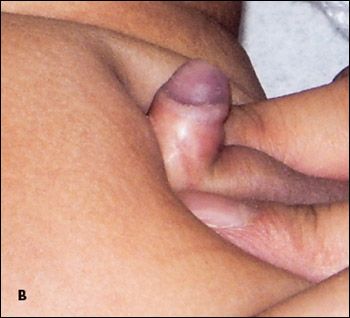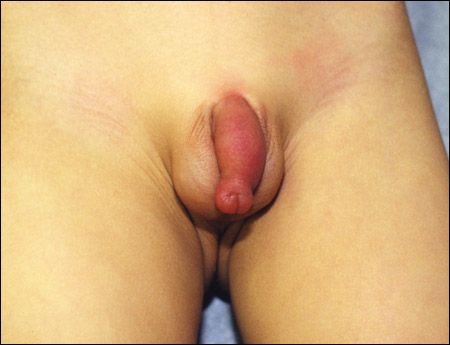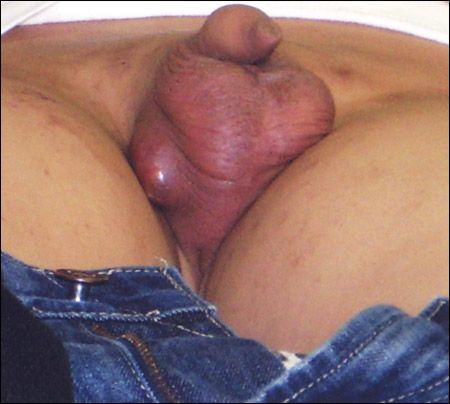A Collage of Genital Lesions, Part 3
A discussion of three types of Genital Lesions: Concealed Penis, Balanoposthitis, and Scrotal Abscess.
Concealed Penis

An 8-month-old infant was brought for evaluation because of concerns about the small appearance of his penis (A). The infant was born to a 25-year-old mother after an uncomplicated, full-term pregnancy and normal vaginal delivery. Birth weight and length were 4.2 kg (9.3 lb) and 52 cm (20.5 in), respectively. Circumcision was performed in the neonatal period.
The infant's current weight and length were 10.2 kg (22.6 lb) and 77 cm (30.3 in), respectively. The penis became noticeable when pressure was applied to adjacent skin (B). The stretched penile length was 3.2 cm (1.25 in), which is normal for the patient's age. Both testes were descended. The urethral meatus and scrotum were normal.
An otherwise normal penis that appears small-a concealed penis-can have any of a number of causes. These include excess peripubic fat; a deficiency of penile shaft skin, such as from overzealous circumcision; and poor attachment of the penile skin and dartos fascia to the Buck fascia and corporeal bodies.

A concealed penis must be differentiated from a micropenis-a penis that measures less than 2 standard deviations below the mean for age in stretched length from the pubic symphysis to the tip of the glans penis. A micropenis often results from gonadotropin deficiency. When this condition is associated with hypoglycemia, suspect panhypopituitarism.
A concealed penis is asymptomatic. It often resolves at puberty, as the penis size increases and the peripubic fat shrinks.
FOR MORE INFORMATION:
• Osman H, Batley NJ. Buried penis in the newborn.
Clin Pediatr (Phila)
. 2006;45:281-283.
• Radhakrishnan J, Razzaq A, Manickam K. Concealed penis.
Pediatr Surg Int
. 2002;18:668-672.
• Sivakumar B, Brown AA, Kangesu L. Circumcision in "buried penis"-a cautionary tale.
Ann R Coll Surg Engl
. 2004;86:35-37.
Balanoposthitis

For 2 days, an uncircumcised 5-year-old boy had penile pain and a yellow discharge from the penis. There was no associated fever. The boy had no history of trauma or similar episode.
On examination, the foreskin and glans were warm, erythematous, tender, and suppurative, consistent with balanoposthitis-infection of the glans and foreskin. There was no lymphadenopathy in the groin area.
Cultures of the exudate are desirable and often reveal mixed organisms. Causative organisms include Staphylococcus aureus; groups A, B, and D streptococci; coliforms; Pseudomonas aeruginosa; and Candida albicans and Trichomonas vaginalis in sexually active males.
Recurrent balanoposthitis may lead to preputial scarring and phimosis. Diabetes mellitus must be excluded in children with recurrent infection.
Balanoposthitis responds well to topical antibiotic therapy. When cellulitis is present, add a systemic antibiotic to the treatment. Optimal genital hygiene is important as a preventive measure. Recurrent balanoposthitis is an indication for circumcision.
FOR MORE INFORMATION:
• Leung AK, Kao CP. A collage of infectious diseases in children.
Consultant for Pediatricians
. 2004;3:481-487.
Scrotal Abscess

This painful mass on the right side of the scrotum of a 5-year-old boy had been present for 7 days. The mass was so painful that the child had to walk with a limping gait. He had no fever. Past health was unremarkable.
The erythematous, fluctuant mass measured 1.5 × 2.5 cm and was exquisitely tender. There was also a tender lymph node of 1 cm in diameter in the right groin area. Incision and drainage of the mass revealed frank pus. Culture of the pus grew Staphylococcus aureus.
A scrotal abscess may present with a tender scrotal mass, redness and edema of the scrotal wall, and fever. It may mimic testicular torsion in infants and neonates. The most common causative organism is S aureus, although coliforms may also cause an abscess in this location. Occasionally, a scrotal abscess may follow an appendectomy, especially if the appendix is perforated and the processus vaginalis is patent.
Treatment consists of incision and drainage of the abscess and therapy with an oral β-lactam–resistant antistaphylococcal antibiotic. If the clinical response is less than satisfactory, the antibiotic can be modified according to the culture and sensitivity results.
This child was treated with cloxacillin (250 mg 4 times a day for 10 days). He had an uneventful recovery.
FOR MORE INFORMATION:
• Leung AK, Robson WL. Scrotal abscess.
Can J Diagn
. 2006;23:58.
• Raveenthiran V, Cenita S. Scrotal abscess mimicking testicular torsion in infants and neonates.
J Pediatr Surg
. 2007;42:597-598.
• Thakur A, Buchmiller T, Hiyama D, et al. Scrotal abscess following appendectomy.
Pediatr Surg Int
. 2001;17:569-571.
Recognize & Refer: Hemangiomas in pediatrics
July 17th 2019Contemporary Pediatrics sits down exclusively with Sheila Fallon Friedlander, MD, a professor dermatology and pediatrics, to discuss the one key condition for which she believes community pediatricians should be especially aware-hemangiomas.